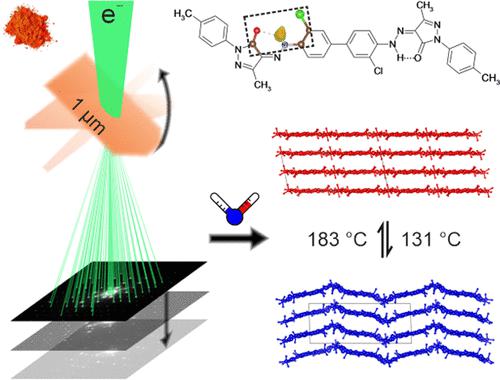当前位置:
X-MOL 学术
›
J. Am. Chem. Soc.
›
论文详情
Our official English website, www.x-mol.net, welcomes your feedback! (Note: you will need to create a separate account there.)
High Temperature Electron Diffraction on Organic Crystals: In Situ Crystal Structure Determination of Pigment Orange 34
Journal of the American Chemical Society ( IF 15.0 ) Pub Date : 2024-03-27 , DOI: 10.1021/jacs.3c14800 Yaşar Krysiak 1 , Sergi Plana-Ruiz 2, 3 , Lothar Fink 4 , Edith Alig 4 , Ulrich Bahnmüller 1 , Ute Kolb 2, 5 , Martin U. Schmidt 4
Journal of the American Chemical Society ( IF 15.0 ) Pub Date : 2024-03-27 , DOI: 10.1021/jacs.3c14800 Yaşar Krysiak 1 , Sergi Plana-Ruiz 2, 3 , Lothar Fink 4 , Edith Alig 4 , Ulrich Bahnmüller 1 , Ute Kolb 2, 5 , Martin U. Schmidt 4
Affiliation

|
Small molecule structures and their applications rely on good knowledge of their atomic arrangements. However, the crystal structures of these compounds and materials, which are often composed of fine crystalline domains, cannot be determined with single-crystal X-ray diffraction. Three-dimensional electron diffraction (3D ED) is already becoming a reliable method for the structure analysis of submicrometer-sized organic materials. The reduction of electron beam damage is essential for successful structure determination and often prevents the analysis of organic materials at room temperature, not to mention high temperature studies. In this work, we apply advanced 3D ED methods at different temperatures enabling the accurate structure determination of two phases of Pigment Orange 34 (C34H28N8O2Cl2), a biphenyl pyrazolone pigment that has been industrially produced for more than 80 years and used for plastics application. The crystal structure of the high-temperature phase, which can be formed during plastic coloration, was determined at 220 °C. For the first time, we were able to observe a reversible phase transition in an industrial organic pigment in the solid state, even with atomic resolution, despite crystallites being submicrometer in size. By localizing hydrogen atoms, we were even able to detect the tautomeric state of the molecules at different temperatures. This demonstrates that precise, fast, and low-dose 3D ED measurements enable high-temperature studies the door for general in situ studies of nanocrystalline materials at the atomic level.
中文翻译:

有机晶体高温电子衍射:颜料橙 34 晶体结构的原位测定
小分子结构及其应用依赖于对其原子排列的充分了解。然而,这些化合物和材料的晶体结构通常由细晶域组成,无法通过单晶 X 射线衍射来确定。三维电子衍射 (3D ED) 已经成为亚微米有机材料结构分析的可靠方法。减少电子束损伤对于成功确定结构至关重要,并且常常妨碍在室温下对有机材料进行分析,更不用说高温研究了。在这项工作中,我们在不同温度下应用先进的 3D ED 方法,能够准确测定颜料橙 34 (C 34 H 28 N 8 O 2 Cl 2 )的两相结构,颜料橙 34 是一种联苯吡唑啉酮颜料,已工业化生产了超过80 年历史,用于塑料应用。塑料着色过程中形成的高温相的晶体结构在 220 °C 下测定。我们首次能够在固态工业有机颜料中观察到可逆相变,即使是原子分辨率,尽管微晶尺寸为亚微米级。通过定位氢原子,我们甚至能够检测不同温度下分子的互变异构状态。这表明,精确、快速和低剂量的 3D ED 测量为高温研究打开了原子水平纳米晶体材料的一般原位研究之门。
更新日期:2024-03-27
中文翻译:

有机晶体高温电子衍射:颜料橙 34 晶体结构的原位测定
小分子结构及其应用依赖于对其原子排列的充分了解。然而,这些化合物和材料的晶体结构通常由细晶域组成,无法通过单晶 X 射线衍射来确定。三维电子衍射 (3D ED) 已经成为亚微米有机材料结构分析的可靠方法。减少电子束损伤对于成功确定结构至关重要,并且常常妨碍在室温下对有机材料进行分析,更不用说高温研究了。在这项工作中,我们在不同温度下应用先进的 3D ED 方法,能够准确测定颜料橙 34 (C 34 H 28 N 8 O 2 Cl 2 )的两相结构,颜料橙 34 是一种联苯吡唑啉酮颜料,已工业化生产了超过80 年历史,用于塑料应用。塑料着色过程中形成的高温相的晶体结构在 220 °C 下测定。我们首次能够在固态工业有机颜料中观察到可逆相变,即使是原子分辨率,尽管微晶尺寸为亚微米级。通过定位氢原子,我们甚至能够检测不同温度下分子的互变异构状态。这表明,精确、快速和低剂量的 3D ED 测量为高温研究打开了原子水平纳米晶体材料的一般原位研究之门。



























 京公网安备 11010802027423号
京公网安备 11010802027423号